This website is supported by its readers. If you click one of my links I may earn a commission. I am also a participant in the Amazon affiliates program and I will also earn a commission from qualified purchases.
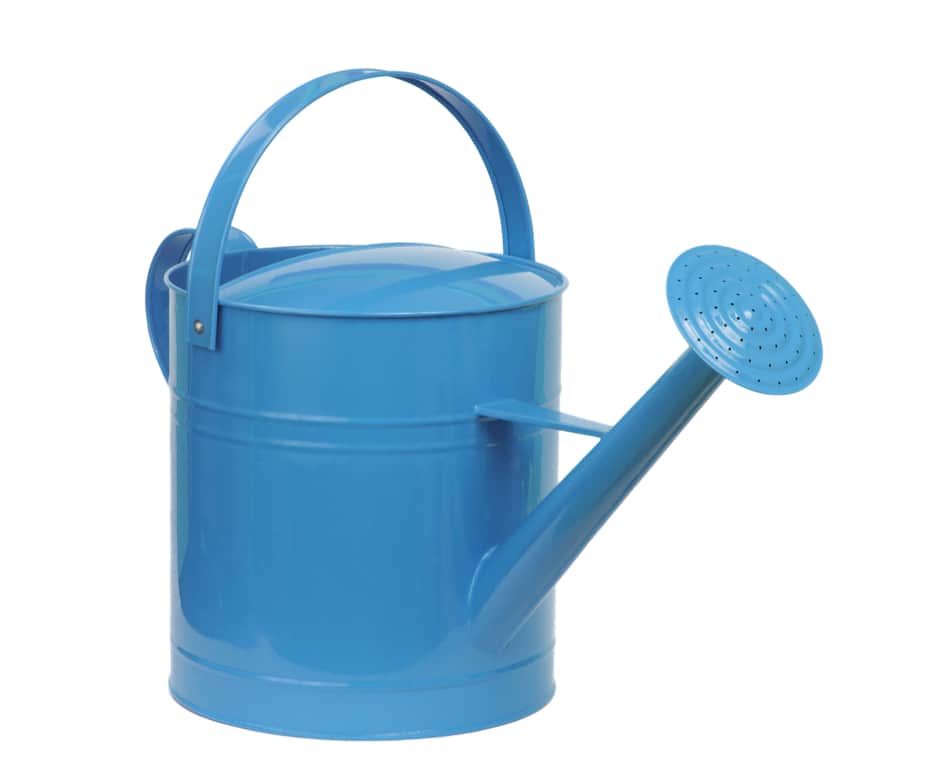
One of the things that I worried about when I first started my bonsai collection was exactly how frequently I should be watering them. I set up a schedule where I would water my bonsai once a day, regardless of if the soil was dry or not, which is something I now know should be avoided! So can you overwater a bonsai tree?
It’s possible to overwater a bonsai tree. This is caused when the soil or plant pot does not pass through water, holding onto moisture, and depriving your bonsai roots of oxygen. This causes yellowing leaves and the shriveling of branches. To avoid this, only water your bonsai when the topsoil is dry.
So what are the symptoms of overwatering your bonsai tree, and what can you do to avoid overwatering a bonsai tree? Keep reading to find out more!
Just a quick heads up, over the past three years of running Plantpaladin, hundreds of people have asked for product recommendations. As such, You can find my favorite indoor bonsai tree here (link takes you to Bonsaiboy), my favorite outdoor bonsai tree (link takes you to Bonsaiboy), or have a look at all the products I recommend here.
Can you overwater a bonsai tree?
Underwatering is one of the most common causes of killing a bonsai – regardless of the species.
Mainly because bonsai are usually kept in small pots, with shallow soil, meaning that it is super easy to dry out.
So what about overwatering? After all, this is usually a lot less common than under-watering so is it still possible?
Over the past few years, I’ve made many mistakes, and have over-watered more than a fair few plants.
To summarize:
- Overwatering a bonsai is possible
- This usually happens if your soil does not pass water or moisture through effectively
- If you keep your bonsai in a pot without any drainage holes overwatering is also possible
- Overwatering your bonsai essentially drowns your roots which need oxygen to survive as other plants do.
- This will then cause your secondary branches to start shriveling and your leaves to turn yellow and brown.
- Left to itself this can lead to root rot which can cause fungal infections in your plant.
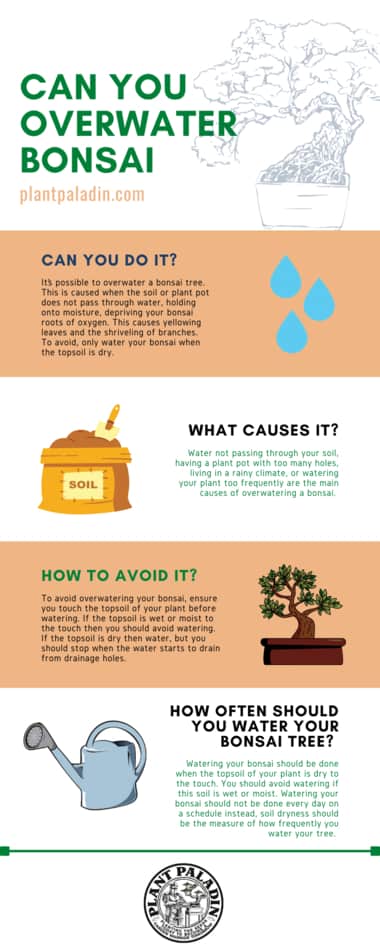
What factors cause you to overwater a bonsai tree?
Water not passing through your soil, having a plant pot with too many holes, living in a rainy climate, or watering your plant too frequently are the main causes of overwatering a bonsai.
Let’s explore these in more detail below:
Having a plant pot with too few holes
A major issue that can contribute to overwatering a bonsai is having a pot with no or too few holes.
Whilst some of these pots might look visually pleasing, the primary purpose of a bonsai pot is to hold soil and let water flow through them.
To avoid this then, ensure that your bonsai has enough holes for the sizer of your tree.
| Classification | Size inches | Number of penny-sized holes | Number of pencil-sized holes |
| Keshitsubo | 1 to 3 inches | 1-2 | 0 |
| Shito | 2 to 4 inches | 1-2 | 0 |
| Mame | 2 to 6 inches | 2 | 2 |
| Chohin | 5 to 8 inches | 2 | 2 |
| Kumono | 6 to 10 inches | 2 | 2 |
| Katade-mochi | 10 to 18 inches | 2 | 3 |
| Chiu or Chumono | 16 to 36 inches | 2 | 4 |
| Dai or Omono | 30 to 48 inches | 3 | 6 |
| Hachi-uye | 40 to 60 inches | 4 | 8 |
| Imperial | 60 to 80 inches | 6 | 8 |
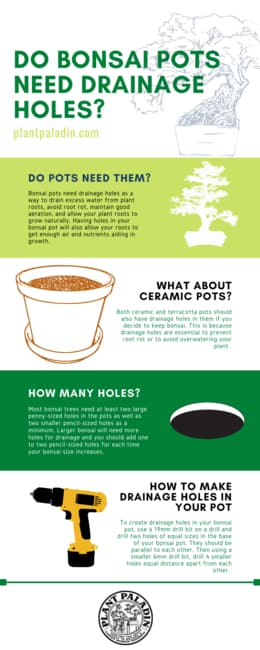
To read up more on bonsai size classification – check out this post here.
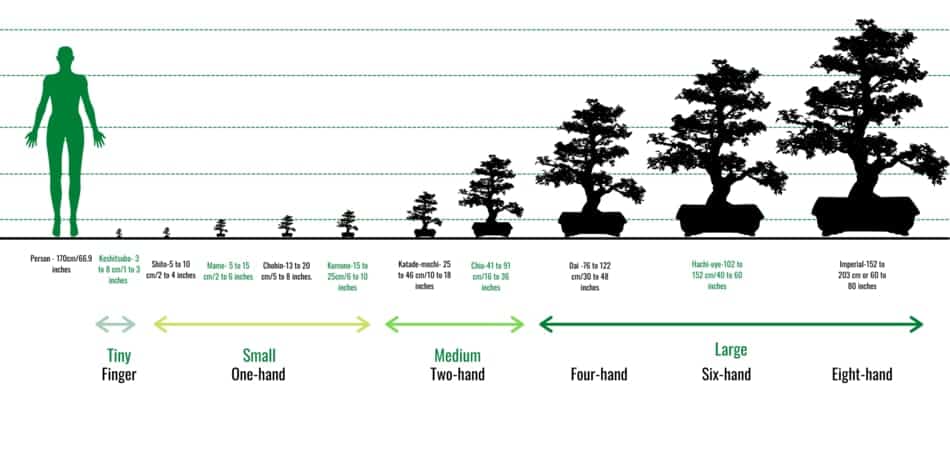
Living in a rainy climate
Where I‘m based in the UK, around 4 months of the year typically non-stop rain.
Heck, even in the summer months sometimes we have a washout instead of a nice long heatwave.
As such, if you live in a climate with excessive rain and you keep your bonsai outdoors or planted in the ground, then it may be the excessive rain that is causing you to overwater your bonsai.
Instead, try to keep your bonsai in a shelter or nursery or indoors if possible.
Building your bonsai greenhouse could also be a good option to protect your plant from the elements in the summer or winterizing or building a cold frame for your tree is a good option to avoid excess water in the winter months.
Water not passing through your soil
One of the biggest causes of overwatering a bonsai tree is just that your bonsai soil holds on to too much moisture.
You must find a soil mix that not only holds onto water to hydrate your plant but also allows any excess water to pass through easily.
This can typically be done with soils such as peat soil or soil with a mix of sand, pebbles, and other inorganic items such as akadama, perlite, or pumice as a way to help filter the water out.
Using soil that holds on to moisture too much will have the opposite effect so ensure you create a soil mix that works for your plant.
I like to use cactus soil – to read up more on how I do this check out this post here.
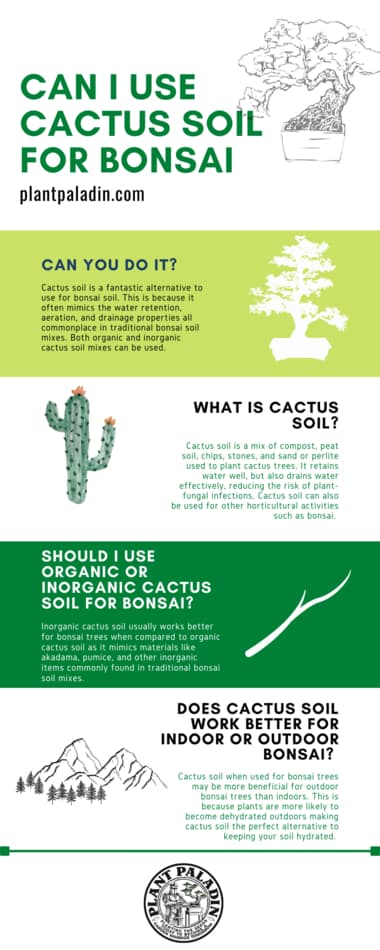
Watering your plant too frequently
Finally comes the most likely cause of overwatering your bonsai tree – you just water it yourself too much.
Whilst most bonsai dry out fairly quickly, you mustn’t come up with a routine for watering your bonsai.
Instead, ensure you touch the topsoil for your bonsai before deciding to water it.
If the topsoil is dry then you can water your plant until the water starts to drain out the holes in your plant pot.
If you feel as though your bonsai dries out excessively quickly then you can water it again in a few hours but once again, only if the topsoil is dry to the touch.
How to avoid overwatering a bonsai?
To avoid overwatering your bonsai, ensure you touch the topsoil of your plant before watering. If the topsoil is wet or moist to the touch then you should avoid watering. If the topsoil is dry then water, but you should stop when the water starts to drain from drainage holes.
Now a common question people have is exactly how much water you should give your bonsai.
This depends on a large number of factors such as:
- The species of plant
- The size of the plant (larger plants typically need more water, smaller plants dry out more frequently)
- The climate you live in
However, a good rule of thumb for most bonsai owners is 300ml works best.
Just ensure that as soon as your bonsai starts to drain water from its drainage holes that you stop watering the plant.
What happens if you overwater your bonsai trees?
Root rot, fungal infections, discolored or wilted leaves, and shriveled branches are all symptoms of overwatering your bonsai. Overwatering your bonsai cuts off the flow of nutrients and oxygen to your plant roots.
Left unchecked, this can also cause the death of your plant.
How often should you water your bonsai tree?
Watering your bonsai should be done when the topsoil of your plant is dry to the touch. You should avoid watering if this soil is wet or moist. Watering your bonsai should not be done every day on a schedule instead, soil dryness should be the measure of how frequently you water your tree.
Typically most bonsai will need to be watered however at least once every few days, with smaller bonsai needing watering more frequently.
What can help prevent overwatering a bonsai tree
Checking your topsoil frequently, inserting a drip water feeder, or keeping your bonsai indoors can all help with preventing over-watering your bonsai. Regularly changing the soil and repotting your plant can also allow water to flow freely as opposed to being held onto by the plant.
What to do if you have overwatered your bonsai?
So if you find yourself having the misfortune that I have had many a time with overwatering bonsai trees there are a few quick fixes that you can do to ensure this does not damage your tree in the long term:
- Leave your bonsai outdoors to dry – The easiest method and works well if you live in a warm climate
- Repot your plant – If your soil is too wet, you need to get your bonsai out of there. The best option is to resolve your bonsai in a new pot. if you find that your bonsai is still fairly wet on the back of this then consider adding more non-organic material to your soil to aid with the drainage
- Wait a few hours for the soil to drain naturally
- Dry your soil with a hairdryer – If it has been a few hours and your bonsai is still dry, then plug in a hot air dryer and blast your soil with heat.
- Plant your bonsai in the ground – sometimes your bonsai will need more room to filter the water out correctly, planting your bonsai in the ground for a few days I found to work incredibly well at drying out roots that have been overwatered. Just ensure you check the weather forecast for that day as the last thing you want is a heavy downpour as soon as you have planted your bonsai.
What do the experts say?
Now I mustn’t just give you my experience but gather information about overwatering plants.
On a recent trip to the local botanical gardens then, I asked one of the staff members their thoughts on overwatering bonsai and this is what they said:
“It’s a lot less common to overwater bonsai than underwater, but still possible, if you check the soil if it’s dry or not that’s the best measure of when you should water these plants” – Botanical Gardens
My top picks for the gear you will need!
So like I mentioned earlier, over the past three years of running PlantPaladin, hundreds of people have asked me for my recommendations on the best bonsai gear on the market.
Having spent thousands of dollars on bonsai items these past few years and tested at least 100 bonsai-specific products, I’ve listed my favorite products below – All of which I highly recommend and think you can get great value.
They can purchase directly by clicking the link to take them to Amazon.
Bonsai Tool Set: One of the significant challenges I’ve had is finding a toolset that was not only durable but didn’t break the bank. SOLIGT has recently developed a fantastic bonsai tool set that covers all the tools you need to trim, prune, and repot your trees. – You can grab it here.
Complete Bonsai Set: Many of you will want to grow your bonsai trees entirely from scratch, but finding the varicose seeds, pots, and other items in one place can be challenging. Leaves and Sole then have created a complete bonsai set that I’ve personally used that ticks all the boxes. You can grab it here.
Bonsai wire: The number of times I’ve run out of wire for my bonsai or purchased cheap bonsai wire that doesn’t do the job is embarrassing for me to admit. After a lot of trial and error, I found that using Hotop’s aluminum bonsai wire is one of the best options on the market. This can easily be used for both indoor and outdoor bonsai. You can grab it here.
